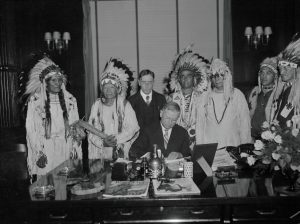Tribal Sovereignty

When thinking about, and prior to engaging in research activities with Indigenous peoples, Tribal nations, and/or Tribal governments and departments, researchers must understand the concept of Tribal sovereignty and how it affects their projects. Sovereignty is the supreme power and authority to self-govern. It is inherent and cannot be given to one group by another. Tribal sovereignty is the ability to govern and protect, and to enhance the health, safety, and welfare of Tribal citizens within Tribal territory (NCAI, 2018). This means that Tribal Nations are political entities that have a political relationship with the US government that does not derive from race or ethnicity. Prior to colonization Indigenous Tribes possessed complete sovereignty. Since the creation of the American legal system, the US Supreme Court has developed a vast body of Federal Indian Law, which makes use of constitutional sources but also draws heavily on the history between Natives and the federal government. Therefore, Tribal sovereignty is rooted in the US constitution, treaties, and court precedence.
The US Constitution recognizes Indian Tribes as distinct governments and states that Congress has exclusive rights and powers to regulate affairs and trade with Indian Tribes. This is known as plenary power, and for the most part, keeps States out of Indian affairs.
In the US, treaties secure Indian rights to their own lands and resources, never compromising their independence. In all, the US ratified 370 treaties with Indigenous peoples. While every one of those treaties has since been violated, treaties are still recognized as the supreme law of the land and are upheld to varying degrees today. The language in these treaties is diverse, however, there are often certain common features of the pacts: a guarantee of peace, a definition of land boundaries, preservation of hunting and fishing rights, and provisions for protection against domestic and foreign enemies.
Three 19th century Supreme Court opinions serve as a cornerstone to understanding the sovereign status of Tribal nations. The cases, known as the Marshall Trilogy, are the most widely cited in Federal Indian Law with respect to Tribal sovereignty. These three cases 1) established federal primacy in Indian affairs (Johnson v. M’Intosh 1823); 2) established the US trust responsibility to Tribes (Cherokee Nation v. Georgia 1831); and 3) recognized Tribal governance authority (Worcester v. Georgia 1832). These cases are considered to have established the place of Tribal nations in the American dual sovereign structure that still governs today.
Researchers have the responsibility of familiarizing themselves with the concept of Tribal sovereignty prior to engaging Tribes and/or Indigenous peoples. In doing so, the researcher takes onus in learning about the peoples they hope to engage with, and lessens the invisible/free labor that Tribes and Indigenous peoples take on when having to “teach” outsiders about their histories and realities. Tribal sovereignty will affect research one way or another. Considerations of permissions needed, jurisdictional boundaries, the significance of traditional and cultural knowledge, teachings, and resources are all tied to sovereignty. Tribal sovereignty entails research and data sovereignty: the right of a Native Nation to decide which and whether research will be conducted, how the data will be used, shared, stored, and reported, and the right to pre-publication review of any intended research products.